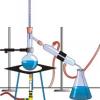Need some advice on water dewpoint spec and mositure content of natural gas.
I have a natural gas feed with high H2S (20%) and CO2 (6%). The gas is to be dehydrated to a dewpoint spec of -40degC at 93 bara. The client equates this to a moisture content of 20ppmv, with plans to install a moisture analyser with an alarm set at this point. I have been trying to reconcile these two figures. I've tried to use STFlash to estimate the saturated water content in the feed at the specified temperature and pressure, and then convert it to STP. I keep coming up with a value of around 5 - 6 ppmv. However I've seen in a few reports and literature online where this same spec (-40degC and 93 bara) is also equated to 20 ppmv or 20 ppm mol.
How would you go about converting a dewpoint spec to a water moisture content? I have attached a file of my gas composition and st flash results (dont know if you use or are familiar with it)
Many thanks for any help!
Warm Regards,
Ogeds

 FB
FB














